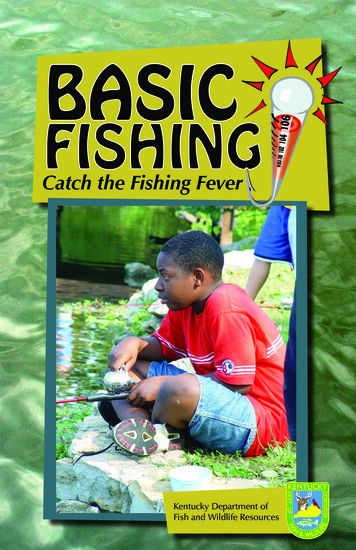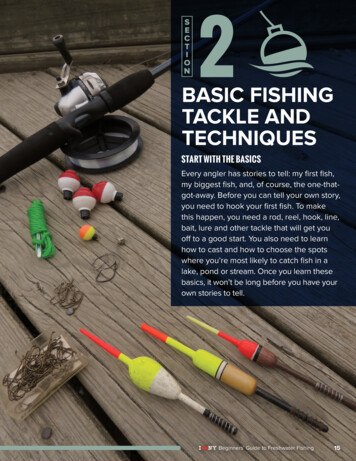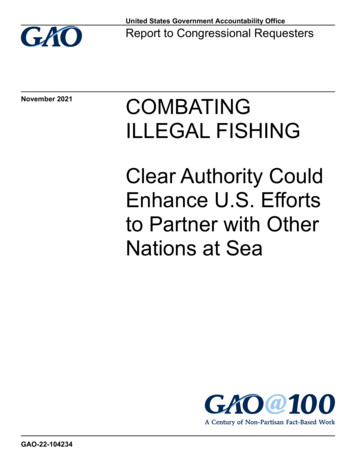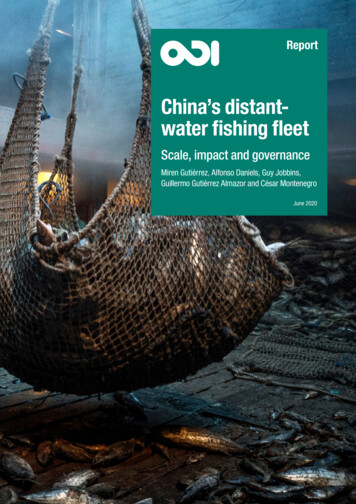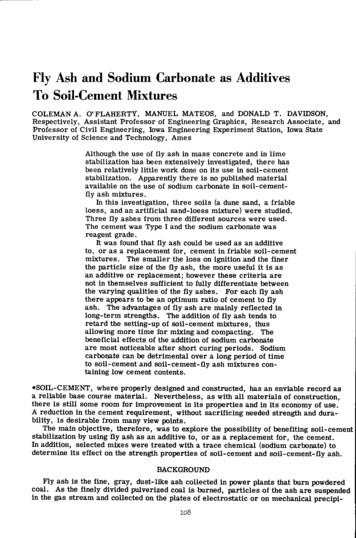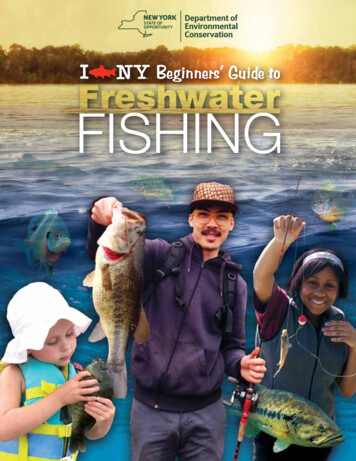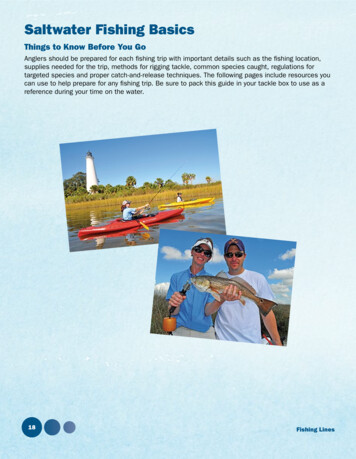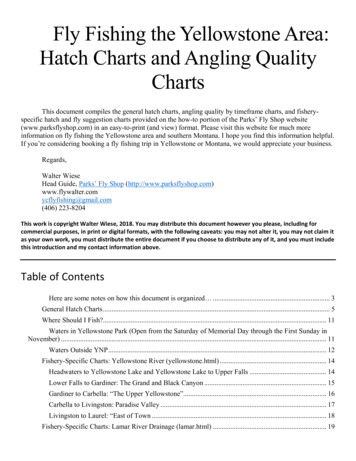
Transcription
Fly Fishing the Yellowstone Area:Hatch Charts and Angling QualityChartsThis document compiles the general hatch charts, angling quality by timeframe charts, and fisheryspecific hatch and fly suggestion charts provided on the how-to portion of the Parks’ Fly Shop website(www.parksflyshop.com) in an easy-to-print (and view) format. Please visit this website for much moreinformation on fly fishing the Yellowstone area and southern Montana. I hope you find this information helpful.If you’re considering booking a fly fishing trip in Yellowstone or Montana, we would appreciate your business.Regards,Walter WieseHead Guide, Parks’ Fly Shop yfishing@gmail.com(406) 223-8204This work is copyright Walter Wiese, 2018. You may distribute this document however you please, including forcommercial purposes, in print or digital formats, with the following caveats: you may not alter it, you may not claim itas your own work, you must distribute the entire document if you choose to distribute any of it, and you must includethis introduction and my contact information above.Table of ContentsHere are some notes on how this document is organized . 3General Hatch Charts . 5Where Should I Fish?. 11Waters in Yellowstone Park (Open from the Saturday of Memorial Day through the First Sunday inNovember) . 11Waters Outside YNP . 12Fishery-Specific Charts: Yellowstone River (yellowstone.html) . 14Headwaters to Yellowstone Lake and Yellowstone Lake to Upper Falls . 14Lower Falls to Gardiner: The Grand and Black Canyon . 15Gardiner to Carbella: “The Upper Yellowstone”. 16Carbella to Livingston: Paradise Valley . 17Livingston to Laurel: “East of Town . 18Fishery-Specific Charts: Lamar River Drainage (lamar.html) . 19
Walter J. WieseLamar River Mainstem . 19Soda Butte Creek . 20Slough Creek . 21Fishery-Specific Charts: Madison River Drainage (madison.html) . 22Firehole River . 22Gibbon River . 23Madison River: Madison Junction to Riverside Drive . 24Madison River: Riverside Drive to Hebgen Lake. 25Fishery-Specific Charts: Gardner River (gardner.html) . 26Headwaters to Osprey Falls . 26Osprey Falls to Yellowstone Confluence . 27Fishery-Specific Charts: Small Streams (smallstreams.html) . 28Any Small Stream Primarily Populated by Brook Trout . 28Small Meadow Streams Containing Smaller Trout . 29Steep/Rough Small Streams, aka “Mountain Creeks” . 30Spring Creeks (springcreeks.html). 31Lakes (lakes.html) . 32Low Elevation Private Ranch Lakes . 32Small, Shallow, High-Elevation Lakes . 33Large (3000 Acre) High-Elevation Lakes or Reservoirs . 34Large (3000 Acre) Low-Elevation (Under 6000 Feet) Reservoirs . 352
Walter J. WieseHere are some notes on how this document is organized First up is the general section of the document, which includes general hatch charts for importantinsects in the region, organized by month. Separate charts are given for each insect type (mayflies, caddisflies,etc.). Except where scientific names are often used instead of the common names, I have used the most commonlocal name for a given insect. Within each chart, the insects of greatest general importance are listed first, withthe least-important listed last. Note that this is a region-wide assessment. Certain insects might not be veryimportant overall but be very important on one specific body of water, or just happen to pop one day on a waterwhere they are not usually important.An uppercase X means the hatch is of major importance. A lowercase x means it is of minor importance.A question mark beside either means the hatch is of variable quality in this timeframe. This usually means thehatch is highly dependent on water levels and/or air and water temperatures, and the question mark occurs at thebeginning and/or end of the possible hatch timeframe. If there’s a blank, it means a given insect is unlikely to beimportant at a certain timeframe.I have not included insects that are of minor importance, only those that anglers stand say a 25% chanceof seeing if they’re in the region at a given timeframe on a body of water that possesses a reasonable number ofthese insects.The second part of the document is a chart entitled and answering the question “When Should I Come?”This is the single most common question I get. In this chart, I cover the good, fair, and ugly times to come tofish a given water or water type. An “X” means it’s prime, one of the best available options. An “x” means it isdefinitely worth fishing but there are better areas to focus on. A question mark after either denotes uncertainty,usually indicating the potential but not certainty for spring runoff, water temperatures that might be too warm(summer), or water temperatures that might be too cold, in the autumn. A blank indicates that the water inquestion is either closed or a terrible option at the given time.Note that these charts do not quite match those given with each entry in the fishery-specific sectiondescribed below, due to a slightly different organization and purpose. For example nowhere is likely to offermore than “fair” fishing in the dead of winter, but in this section of the document portions of the Missouri aredescribed with an “X” in January simply because it’s one of the few places to fish at this time at all, while in thethird section it gets an “x” reflecting the fact it’s likely not going to gangbusters fishing. In other words,fisheries in the “When Should I Come” section are described in relation to each other. In the fishery-specificsection, they’re described in relation to their overall fishing quality.The fishery-specific section of this document comes next. It is the larger section. Each entry in thissection might cover an entire river, a section of a river or river drainage, or a type of water (i.e. “spring creeks”or “small lakes in Yellowstone Park”). Each fishery-specific entry begins with a chart describing the likelyangling quality over the course of the year or legal fishing season. On these charts, an uppercase X specifiesexcellent angling quality for the water in question. Comparing different waters is an apples to orangescomparison. For example both the upper Yellowstone River near Yellowstone Lake and beginner brook troutfisheries are great in late July. On the upper Yellowstone this means experts might get two or three huge fish.On the brookie creeks it means rookies stand a good chance of catching a half a dozen tiny trout. Again, aquestion mark suggests uncertainty. Again this mostly depends on weather and water conditions.Each entry in this section continues with a chart covering good aquatic insect hatches, good terrestrialand attractor dry flies, and good subsurface flies. A big X means a given hatch or fly type is a good bet. A smallx means it’s a secondary tactic. A blank means a hatch probably isn’t important or a tactic isn’t worthwhile. Aquestion mark next to an X again denotes uncertainty and usually depends on weather/water conditions. In thissection of the document, insect hatches are organized by importance, from greatest to least, with insects3
Walter J. Wieseorganized first by important family, then by important species. So in the Lamar River Drainage, where mayfliesare the most important insect family, they are presented first. In the canyon sections of the Yellowstone, wherestoneflies are more important, they come first.Charts in this section are broken down by month for fisheries in Montana, which are generally openyear-round, and are broken down in two-week blocks for fisheries in Yellowstone National Park, where thegeneral season runs from sunrise on the Saturday of Memorial Day Weekend in late May (the “M” in the charts)through sunset on the first Sunday in November (the “N” in the charts). Where the open fishing season differsfrom the general season in whatever jurisdiction, or factors like muddy water, geothermal (geyser) water, or icemake a body of water unfishable, this will be noted on the chart.Note that the titles of most tables in both sections of this document include a web address in parentheses,i.e. “(mayflies.html).” Simply add a slash and this page designation to www.yellowstoneflyfishing.info to visitthis page, i.e. www.yellowstoneflyfishing.info/mayflies.html. These pages go into far more detail about eachinsect type. Basically, this document just has the charts in an easy-to-print format.Now, on to the document 4
Walter J. WieseGeneral Hatch ChartsMayfly Hatch Chart (mayflies.html)Blue-winged le Morning DunWestern Green Drakeand Little Green Drakex?CallibaetisJulDrake tern Sulfur(Cream Baetis)xxMahoganyxxxxxWestern March BrownxXXWestern Cahill(Epeorus)Gray DrakexxxBrown Drakexxx5Dec
Walter J. WieseCaddisfly Hatch Chart (caddisflies.html)JanFebMarAprMayTan CaddisOlive (Mother’s Day)Caddisx?JunJulAugXXXSepOctxxXxxxxxGreen RockwormxxxTraveling SedgexxxxGiant Brown CaddisxxJunJulAugSepOctAmber CaddisxxMicrocaddis(Glossosoma)xxxxWhite Miller*JanFebMarAprMayOctober CaddisNovDecNovDec*Note: The White Miller (Nectopsyche) caddis is rare to absent in most waters and only of moderate importance in theGibbon and Madison Rivers. It is placed so highly in the above list because it is far and away the single most importantinsect present in the Firehole River. You will see these bugs if you fish the Firehole for several days any time betweenearly June and late September.6
Walter J. WieseStonefly Hatch Chart x?XXx?Golden Stoneflyx?XXx?XXMidnight StoneflyYellow Sallyx?xXX?Little Olive Stoneflyx?xXxTiny Black Stoneflyxxx7SepxOctNovDec
Walter J. WieseOther Aquatic Insects (otherinsects.html)“Winter” MidgesJanFebMarxXXAprMayJunxLarge Black MidgeJulAugSepOctNovDecxxxx“Lamar” Midgexxx“Missouri” MidgesxxXXXxxxxxxx“Spring Creek” selflies*CranefliesWater Boatmen &Backswimmers*xx*Note: Insects marked with an asterisk are generally only important in lakes.8
Walter J. WieseTerrestrial Insect Hatch Chart Crickets & CicadasXxXxLarge GrasshoppersxXxxSpruce MothxxxLarge BeetlesxxxxxxxAnts*FebMarAprSmall GrasshoppersxSmall BeetlesMormon CricketsxBeesOctxNote: Possible ant importance in May and June is generally limited to spring creeks.9NovDec
Walter J. WieseOther Trout Food ecBaitfish (Streamers)xxXXXxxxxXXxRiver XRiver Worms1xxxXXxxxxLake ake Scuds2Crayfish3xxxMicexx1.) Primarily important in tailwaters (Missouri and Lower Madison), but may also work in spring creeks. Wormimitations occasionally work in freestone streams at the tail end of runoff or after summer storms.2.) Most useful in fertile, weedy lakes.3.) Crayfish are only found in fishable numbers in the Lower Madison, the Yellowstone east of Livingston, theMissouri, and a handful of low-elevation lakes.10x
Walter J. WieseWhere Should I Fish?Waters in Yellowstone Park (Open from the Saturday of MemorialDay through the First Sunday in November)Yellowstone RiverMLake to FallsGrand CanyonBlack 5X?X?XXXxXXXXXXXxxxxx10/15NNxLamar River DrainageMLamar RiverSoda Butte CreekSlough XXXXXxXXxxxxxx9/19/1510/110/15Nx?Gardner RiverMHeadwaters to OspreyFallsOsprey Falls toBoiling RiverBoiling River toYellowstone adison River DrainageFirehole RiverGibbon RiverMadison River,HeadwatersMadison River,Riverside to X
Walter J. WieseOther Yellowstone Park WatersMGallatin River in YNPFalls & BechlerRiver SystemLewis ChannelLewis RiverHeadwaters Snake R.Meadow CreeksRough MountainCreeksBrook Trout CreeksSmall LakesLarge xxxxxXXxX?XXXxxX?xxXxxXxXxxNXXxWaters Outside YNPYellowstone RiverJanApr May JunJulAugSepOctNovDecXX?X?XXXXXGardiner to Carbella*Carbella toXXX?X?XX?XXXLivingston*xXX?X?XXXLivingston to Laurel*Note: The marked sections of the Yellowstone typically enter runoff sometime in the first half of May and drop out ofrunoff in the last ten days of June or first week of July. They are typically excellent right up until runoff begins and theinstant they are low enough and clear enough to fish.Madison RiverHebgen L. to Quake L.Quake L. to Ennis L.Ennis L. to JulAugSepxOctxxNovxxXxx?xxDecxGallatin RiverYNP Line to Big SkyBig Sky toGallatin GatewayG.G. to Three xDecx?XxxXxxx?xxx12Jun
Walter J. WieseMissouri RiverJanThree Forks toCanyon Ferry LakeHauser Dam toHolter LakeHolter Lk to xOther WatersSpring CreeksMountain StreamsPrivate LakesLarge ReservoirsJanXFebXMarXX?X?AprxXXMayXXJunX?XX13x
Walter J. WieseFishery‐Specific Charts: Yellowstone River(yellowstone.html)Headwaters to Yellowstone Lake and Yellowstone Lake to UpperFallsAngling QualityM6/16/157/1CLOSED UNTIL 7/157/15X8/1x8/15x9/19/1510/110/15NAquatic InsectsMPMDWestern Green DrakeGray DrakeBWOLittle Green DrakeEpeorusHeptageniaTan CaddisChocolate CaddisMicrocaddisOlive CaddisSalmonflyGolden StoneflyYellow SallyLittle Olive restrials and AttractorsMLarge Attractor DriesSmall Attractor DriesGrasshoppersBeetles and face FliesMMayfly NymphsCaddis PupaeStonefly 15
Walter J. WieseLower Falls to Gardiner: The Grand and Black CanyonAngling x?X?XXXXXx?x?x?Note: The Grand Canyon upstream from the Lamar Canyon may occasionally be fishable in late May and early June.The Black Canyon between the Lamar and the town of Gardiner is never fishable before mid-late June.Aquatic InsectsMSalmonflyGolden StoneflyYellow SallyMidnight StoneTan CaddisGiant Brown CaddisOlive CaddisBWOWestern Green DrakePMDDrake MackeralEpeorusMahoganyLarge Black ?xx?x?x?Terrestrials and AttractorsM6/1Large Attractor DriesSmall Attractor DriesGrasshoppersAntsCicadas & CricketsMormon 1XXXxXx9/15xXxxXx10/1XxxxSubsurface FliesStreamersStonefly NymphsAttractor NymphsMayfly Xx9/1XxXx9/15Xxxx10/1Xxxx10/15XxxxNXxxx
Walter J. WieseGardiner to Carbella: “The Upper Yellowstone”Angling ovX?DecAquatic InsectsJanTan CaddisOlive CaddisGiant Brown CaddisSalmonflyGolden StoneflyMidnight StoneYellow SallyBlue-winged OliveDrake MackeralMahoganyWestern Green DrakePMDMarch epOctNovXxxXxxxxxDecxxxTerrestrials and AttractorsSmall Attractor DriesAntsGrasshoppersLarge Attractor DriesCrickets & CicadasSpruce xXxXxxxxSubsurface FliesStonefly NymphsAttractor NymphsCaddis PupaeMayfly NymphsStreamersMidge Larvae &PupaeEgg XxJulXXxXXxxx16x
Walter J. WieseCarbella to Livingston: Paradise ValleyAngling ?XX?XXX?Note: High water temperatures can cause problems here in August during low-water years, but closures are uncommon.Just expect to fish only in the morning if the river is low and warm.Aquatic ctxxNovxxDecxxxxxXxXxxxxTan Caddisx?X?Olive Caddisx?xx?Giant Brown CaddisxxMicrocaddisXXxMidnight Stonex?xxYellow SallyX?X?Salmonfly*X?X?Golden Stonefly*x?x?x?xxX?XXxBlue-winged OlivexxxDrake MackeralxxMahoganyx?xWestern Green Drakex?xxPMDxxMarch BrownxxxxxxxMidges*Note: Salmonfly and Golden Stonefly populations are heavy but location-specific in this stretch. Look for fast andturbulent areas with large cobble and boulders as bottom substrate.Terrestrials and AttractorsAntsSmall Attractor DriesGrasshoppersLarge Attractor DriesCrickets & CicadasSpruce e FliesStonefly NymphsAttractor NymphsCaddis PupaeMayfly NymphsStreamersMidge Larvae lXXxXXx17
Walter J. WieseLivingston to Laurel: “East of TownAngling XXx?*Note: High water temperatures can cause problems here in August during low-water years, but closures areuncommon. Just expect to fish only in the morning if the river is low and warm.Aquatic InsectsJanTan CaddisOlive CaddisBlue-winged OliveDrake MackeralMahoganyPMDMarch BrownMidnight StoneYellow gXSepOctNovXxxXxxxx?xxxXxXxxxxxxDecTerrestrials and AttractorsGrasshoppersAntsLarge Attractor DriesSmall Attractor DriesCrickets & xxxxxXxSubsurface FliesStreamersStonefly NymphsMayfly NymphsAttractor NymphsCaddis PupaeMidge Larvae 8
Walter J. WieseFishery‐Specific Charts: Lamar River Drainage(lamar.html)Lamar River MainstemAngling x?10/15x?NAquatic InsectsM6/1Western Green DrakePMDLittle Green DrakeDrake MackeralBWOTan CaddisSalmonfly*Golden Stonefly*Midnight 9/15XXxxx10/1x?10/15xxxNTerrestrials and AttractorsMGrasshoppersAntsCicadas & CricketsBeetlesMormon CricketsLarge Attractor DriesSmall Attractor /15XXxxxxxx9/1XXxxxxxxNx?xxSubsurface FliesM6/16/157/17/158/18/159/19/15 10/1 10/15Nx?X?XXXXXXXMayfly NymphsX?X?X?xxxxxxAttractor Nymphsx?xxxxxxStreamersx?X?XxxCaddis PupaeMidge Larvae &xxxxxxPupaex?xxxxxxxStonefly Nymphs**Note: Stonefly patterns of any kind are only useful in the Lamar’s canyon sections, not the more-popular meadows.19
Walter J. WieseSoda Butte CreekAngling x?10/15x?NAquatic InsectsM6/16/15Western Green DrakePMDLittle Green DrakeDrake MackeralGray DrakeBWOTan CaddisMidgesYellow /1x9/1510/110/15XXxXxXXXxxxxxNTerrestrials and AttractorsM6/16/157/17/158/18/159/19/15 10/1 10/15xXXXXAntsx?XXXXXGrasshoppersxXXxSpruce Moth*xxxxxBeetlesx?XXxxxCicadas & CricketsxxxxxxSmall Attractor DriesxxxxBeesxxxMormon CricketsNote: Spruce Moths are limited to areas near evergreen trees, particularly upper Soda Butte Creek.NSubsurface FliesMMayfly NymphsCaddis PupaeMidge Larvae &PupaeAttractor 15Xx9/1Xx9/15Xx10/1X10/15XxxxxxxxxxxxxxxxxN
Walter J. WieseSlough CreekAngling ?X?XXxxxx?x?*Note: Late May fishing is rare and consists of streamer fishing suitable for advanced anglers only, but it’s gangbusterswhen it happens. It depends on a late spring runoff.Aquatic InsectsM6/16/157/17/158/18/159/19/15 10/1 10/15X?XXxxWestern Green DrakeXXxxPMDx?xXXXxBWOX?XXxDrake MackeralxxxxxxLittle Green DrakexxxxHeptageniaxxxxGray DrakexxxBrown DrakexxxxTan CaddisxxxxxMidgesxxxYellow Sally*xxxLittle Olive Stonefly*x?xx?Salmonfly*x?xx?Golden Stonefly*Note: Larger stoneflies are limited to the short stretches of rough water, and smaller stoneflies are far morecommon in these areas as well.NTerrestrials and AttractorsMAntsBeetlesGrasshoppersCicadas & CricketsBeesSpruce Moth*Small Attractor xx?X?xxxxxxxxxxxxxxxxNote: Spruce Moths are limited to areas near evergreen trees.10/110/15xxNSubsurface FliesMMayfly NymphsMidge Larvae &PupaeStreamersCaddis PupaeAttractor NymphsStonefly 9/1X9/15X10/1X10/15XxXXXXXxxxxxxxxxxxxxxN
Walter J. WieseFishery‐Specific Charts: Madison River Drainage(madison.html)Firehole RiverAngling ?x*x*x*x*X?XXXX*Note: July and August fishing is limited to the upper Firehole upstream of the Old Faithful closure area, which is asmall, rough mountain stream. The area downstream of Old Faithful is always too warm in midsummer, sometimesbeginning as early as mid-late June, before cooling to fishable temperatures again sometime in early September.Aquatic InsectsM6/16/157/17/158/18/159/19/15 10/1 10/15NX?XXXXXxxWhite MillerX?xOlive CaddisxxxxxTan CaddisXxxXXXBlue-winged OlivexXXPale Morning DunWestern GreenxxxDrake*xxxxLittle Olive StonexxSalmonfly*xxGolden Stone*Notes: Western Green Drakes are present in fishable numbers only above Old Faithful. Large stoneflies are present onlyin the Firehole Canyon.Terrestrials and AttractorsSmall Attractor DriesSmall xx10/15xNxSubsurface Flies7/17/1510/1 10/15NXXXSoft Hackles & WetsXXXMayfly NymphsxxxxXXXAttractor NymphsxxxCaddis PupaeXXXStonefly Nymphs*XXXEgg Patterns*X?x?xxxxStreamersxxxxXSan Juan Worms*Notes: These patterns are primarily useful downstream of Firehole Falls in the autumn, when fall-run brown andrainbow trout may be present.228/1
Walter J. WieseGibbon RiverAngling XxxxxxxXXXNote: Midsummer fishing is limited to the area upstream of Norris Geyser Basin except in cool/wet years, whenmorning fishing downstream may be possible. The area upstream of Virginia Cascades (headwaters) is closed currently.Aquatic InsectsTan CaddisGiant Brown CaddisWhite MillerLittle Olive StoneflyYellow SallyGolden StoneflySalmonflyGiant Black MidgeWestern Green DrakePMDBlue-Winged OliveLittle Green DrakeBrown DrakeTan CaddisWhite MillerM6/1xXxxXxxxxxxX?Xxx6/157/17/158/18/15ROUGH WATER SECTIONSXXxxxxxXxxxxxxxxxMEADOW XXx10/1x10/15xNxxxxxTerrestrials and AttractorsSmall Attractor DriesLarge Attractor DriesSmall 5X8/1X8/15X9/1XxxxxxxxxxxxxSubsurface FliesM6/16/157/17/158/18/159/19/15 10/1 10/15XXXXXXXXXXXAttractor NymphsXxxxXXXStonefly NymphsxxxxxxxxMayfly NymphsXxxxXXStreamersxxxxCaddis PupaexxxXXEgg Patterns*xxxxXXSan Juan Worms*Notes: These patterns are primarily useful downstream of Gibbon Falls in the autumn, when fall-run brown andrainbow trout may be present.23NXXxXXX
Walter J. WieseMadison River: Madison Junction to Riverside DriveAngling X10/15XNXAquatic InsectsMTan CaddisOlive CaddisWhite MillerBlue-winged OlivePale Morning DunSalmonfly*Golden errestrials and AttractorsM6/16/15Small Attractor ace FliesMxxX6/1XXXxxx6/15XXxxxx7/17/158/18/159/19/15 10/1 10/15NxxxxXXXSoft Hackles & Wets*xxxxxxMayfly NymphsxxXXXStreamersxxxxCaddis PupaexxxXXXXXAttractor Nymphs*xxXXXXXStonefly NymphsxxXXXEgg Patterns*xxxxxxSan Juan Worms*Notes: Fish small soft hackles in the early season and big ones late in the year. Other patterns with asterisks areprimarily important for fall-run browns. Note also that stonefly nymphs will only work in the rougher sections withboulder or cobble bottoms.24
Walter J. WieseMadison River: Riverside Drive to Hebgen LakeAngling QualityM6/16/157/17/158/1Very low fish numbers save when fall-run trout present.8/15x?9/1X9/15X10/1X10/15XNXAquatic InsectsMOctober CaddisTan CaddisBlue-winged 0/15xNxxxxxTerrestrials and AttractorsM6/16/157/17/158/18/159/19/15 10/1 10/15NTerrestrials and attractors are poor choices here. A fall-run brown might eat a hopper or a steelhead-style dry fly, butthe subsurface flies below are far better choices.Subsurface FliesMStonefly NymphsAttractor NymphsStreamersSoft Hackles & WetsEgg PatternsSan Juan WormsMayfly NymphsCaddis 9/15XXxxxxxx10/1XXXXXxxx10/15XXXXXxxxNXXXXXxx
Walter J. WieseFishery‐Specific Charts: Gardner River(gardner.html)Headwaters to Osprey FallsAngling /15NAquatic InsectsM6/16/15Tan CaddisYellow SallyAsst’d errestrials and AttractorsM6/1Small Attractor DriesSmall GrasshoppersAntsSpruce 0/110/15N8/15x9/1x9/15x10/110/15NxxxxxSubsurface FliesMAttractor NymphsCaddis PupaeMayfly NymphsSan Juan Worms6/16/15Xxx7/1Xxxx7/15xxx268/1xxx
Walter J. WieseOsprey Falls to Yellowstone ConfluenceAngling X?XXX?X?XXX?X?X?Note: This section may or may not be clear enough to fish before the beginning of July. The lower reach downstream ofthe Boiling River hot spring is sometimes too warm in the afternoon in late July and August. The section upstream ofthis hot spring can get too cold late in the season, depending on day-to-day weather.Aquatic InsectsMSalmonflyGolden StoneflyMidnight StoneYellow SallyTan CaddisGiant Brown CaddisOlive CaddisBlue-winged OliveDrake 10/15XXXNXXXxxxxxxxxxx?xxxTerrestrials and e Attractor DriesXxxxSmall Attractor DriesxSmall GrasshoppersxCrickets & CicadasxLarge GrasshoppersSpruce Moth*Ants*Note: Spruce moths are found only in the canyon section between Osprey Falls and the “High Bridge” east ofMammoth Hot Springs.Subsurface FliesAttractor NymphsStonefly NymphsEgg PatternsCaddis PupaeStreamersMayfly NymphsMXXx6/1XXx6/15XXxxx7/1XX7/15Xx8/1Xxxxx27
Walter J. WieseFishery‐Specific Charts: Small Streams(smallstreams.html)Any Small Stream Primarily Populated by Brook TroutAngling XXxxNote that streams in this category are almost entirely found within Yellowstone Park, within m
An uppercase X means the hatch is of major importance. A lowercase x means it is of minor importance. A question mark beside either means the hatch is of variable quality in this timeframe. This usually means the hatch is highly dependent on water levels and/or air and water temperatures, and the question mark occurs at the


